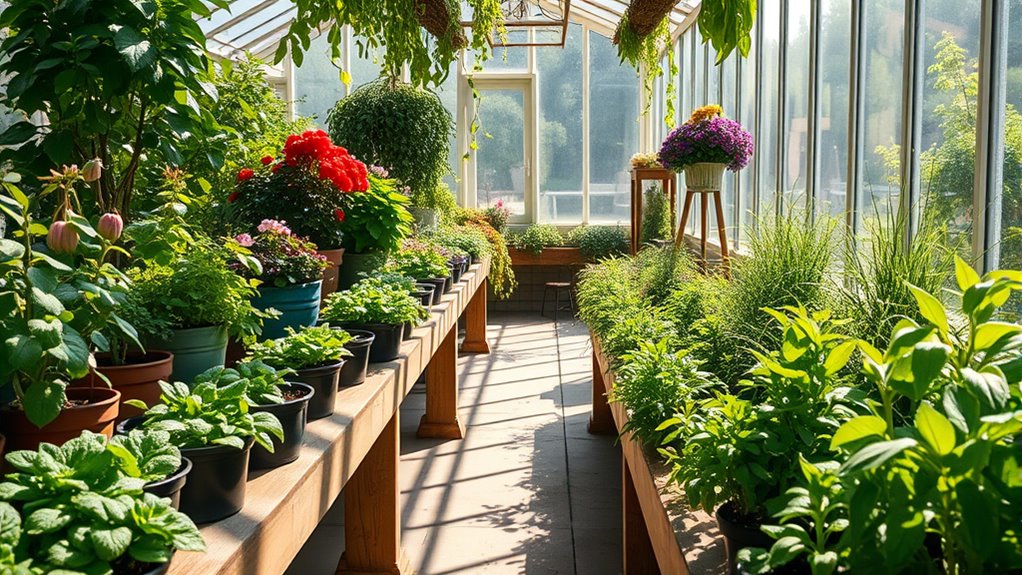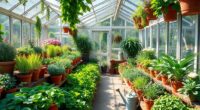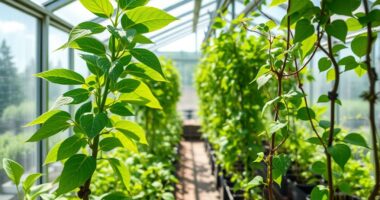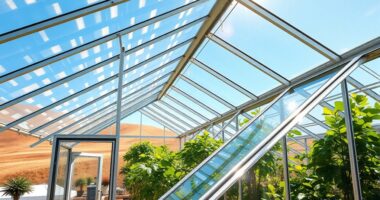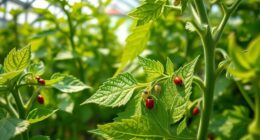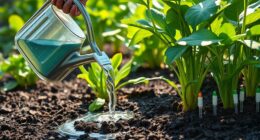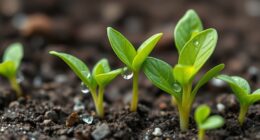To start greenhouse gardening, first, choose a sunny spot with good drainage. Opt for easy-to-grow plants like tomatoes and basil. Use seed trays for propagation and guarantee efficient watering systems, like drip irrigation, to keep moisture levels just right. Don’t forget about climate control and ventilation to maintain ideal conditions. Keep an eye on pests and maintain a clean environment for healthier plants. There’s a lot more to discover about maximizing your greenhouse’s potential.
Key Takeaways
- Choose a well-lit, accessible location with good drainage to set up your greenhouse effectively.
- Start with easy-to-grow plants like tomatoes and spinach, aligning planting with seasonal growth periods.
- Use high-quality potting mix for seed trays and maintain moisture levels for successful germination.
- Implement efficient watering systems, like drip irrigation, to ensure plants receive the right amount of water.
- Regularly monitor for pests and maintain a clean environment to promote healthy plant growth.
Choosing the Right Location for Your Greenhouse
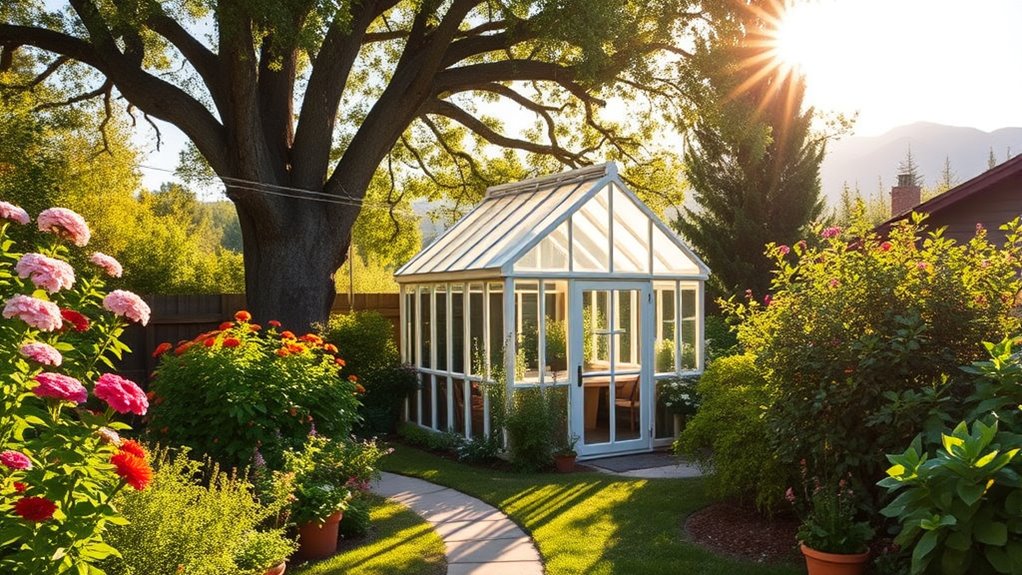
When choosing the right location for your greenhouse, it’s important to take into account several key factors that directly impact plant growth.
First, make sure your site receives at least six hours of direct sunlight daily, as this is essential for healthy plants. Consider seasonal variations in sunlight, and think about using grow lights during winter if needed.
Ensure your greenhouse site gets at least six hours of sunlight daily for optimal plant health.
Proper drainage is fundamental, so choose level ground with well-draining soil to prevent root rot.
Be mindful of wind protection; position your greenhouse where natural or artificial windbreaks can minimize damage.
Finally, assess accessibility to water and electricity sources, guaranteeing easy maintenance and efficient operation.
These considerations will set you up for successful greenhouse gardening.
Selecting Easy-to-Grow Plants
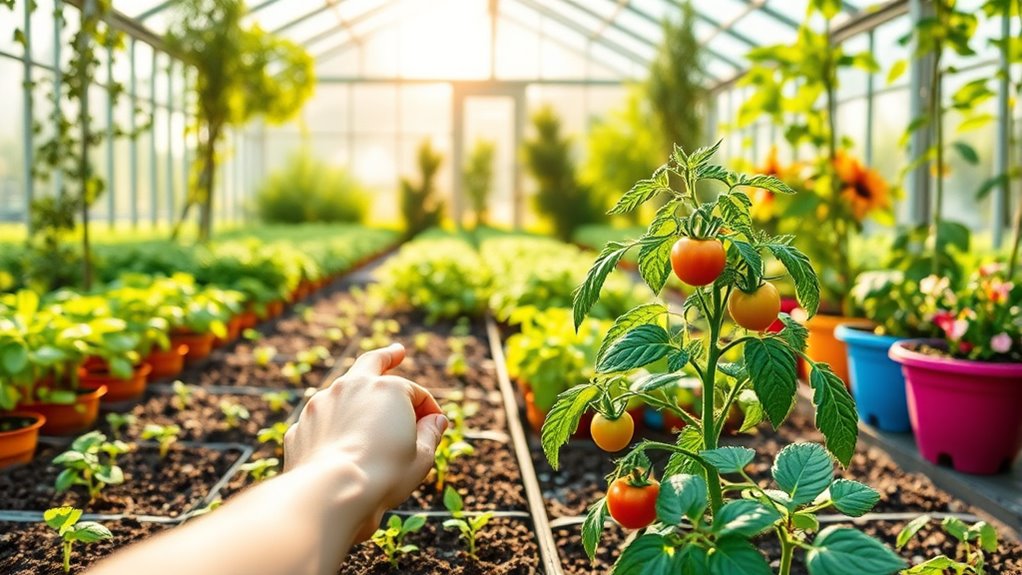
When you’re starting your greenhouse garden, it’s best to choose plants that are easy to grow and well-suited for your climate.
Think about options like tomatoes, spinach, or basil, which thrive in controlled conditions and yield quick results.
Also, consider the seasons to guarantee you plant at the right time for peak growth.
Recommended Beginner Plants
Starting your greenhouse journey with the right plants can set you up for success. Consider growing tomatoes, as they’re easy to cultivate and yield abundant fruit. Additionally, greenhouse gardening allows for a controlled environment that can enhance growth and productivity. Engaging in this practice can also enhance problem-solving skills, as you learn to address challenges that arise in plant care. Understanding the basics of medication management can further improve your gardening experience by ensuring you’re aware of any potential plant care products you might use.
Lettuce and spinach are excellent choices too; they thrive in stable temperatures and offer continuous harvests. For quick results, radishes are ideal, while green onions require minimal care and grow well in cooler conditions.
If you’re drawn to fruits, try ever-bearing strawberries or compact cherry trees, both perfect for greenhouse life. Grapes can flourish in warmth, and citrus fruits like lemons and avocados add a tropical touch.
Don’t overlook herbs; they grow year-round, enhancing your dishes with fresh flavors. Additionally, providing proper care for these plants will ensure they thrive and produce bountiful harvests. These beginner plants will help you build confidence and enjoy your greenhouse experience.
Seasonal Planting Considerations
Selecting easy-to-grow plants for your greenhouse often hinges on understanding seasonal planting considerations. Start by recognizing that day length and temperature influence your planting schedule.
Aim for plants that thrive in your region’s climate. For instance, grow leafy greens in winter and tomatoes in summer. Utilizing your greenhouse’s heating and cooling systems can help maintain ideal conditions year-round.
Implement successive planting to maximize space and guarantee continuous harvests. Remember, shorter growing seasons in colder areas may require you to choose quicker-maturing varieties. Additionally, consider incorporating nutrient-dense plants like leafy greens and herbs that can thrive in diverse conditions and provide essential vitamins.
Effective Propagation and Planting Techniques
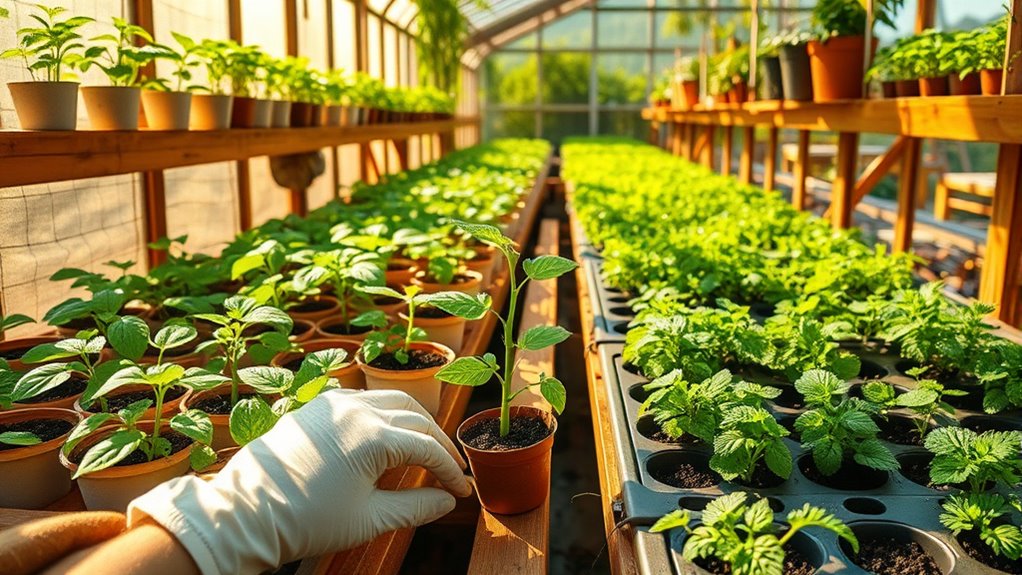
When you’re ready to propagate your plants, seed tray preparation is key to giving them a strong start.
Make sure to use a good quality potting mix and keep the trays moist but not soggy.
Once your seedlings are established, transplanting them properly will help them thrive in your greenhouse environment.
Seed Tray Preparation
To guarantee successful seed propagation, preparing your seed trays properly is essential.
First, choose the right type of tray, like plain level trays or plug trays, based on your seed density needs. Opt for reusable plastic or durable Winstrip trays for sustainability.
Next, fill your trays with a sterile soilless mix, which prevents pathogens and promotes healthy germination. One 8-quart bag typically fills two 10-by-20-inch trays.
When seeding, plant at the correct depth and ascertain proper spacing for airflow. Don’t forget to label each tray with the seed type and date.
Finally, consider using humidity domes to maintain moisture and monitor temperature closely, providing an ideal environment for your seeds to thrive.
Transplanting Seedlings Properly
After your seedlings have emerged and developed into strong candidates for the garden, the next step is transplanting them properly to guarantee their continued growth and vigor.
Start by choosing the right time—wait until they show the first or second true leaf stage. Handle seedlings gently by their leaves to avoid stem injury, and loosen the germination medium around the roots without damaging them.
Prepare your soil by loosening it and adding organic matter for moisture retention, as this practice is essential for maintaining soil health. Use tools like a widger for delicate seedlings and dibble tools for precise holes.
Finally, water thoroughly after transplanting to settle the soil, ensuring your seedlings thrive in their new environment. Incorporating omega-3 rich seeds like chia can also enhance soil health and promote plant growth.
Implementing Efficient Watering Systems

Implementing efficient watering systems is essential for any greenhouse gardener aiming to enhance plant health and conserve resources.
Start by understanding your plants’ specific water needs; different species require varying amounts. Regularly monitor soil moisture to avoid overwatering or underwatering, especially as seasons change.
Understanding your plants’ unique water requirements and monitoring soil moisture is key to preventing overwatering or underwatering.
Consider using drip irrigation, which directs water to roots while minimizing evaporation and waste. Soaker hoses and ollas can also be effective for consistent moisture.
Automate your system with timers and smart management tools to guarantee timely watering based on real-time conditions. Avoid overhead watering to reduce disease risk, and maintain your system regularly for peak performance.
These strategies not only enhance plant growth but also save water and energy in the long run.
Managing Climate Control and Ventilation
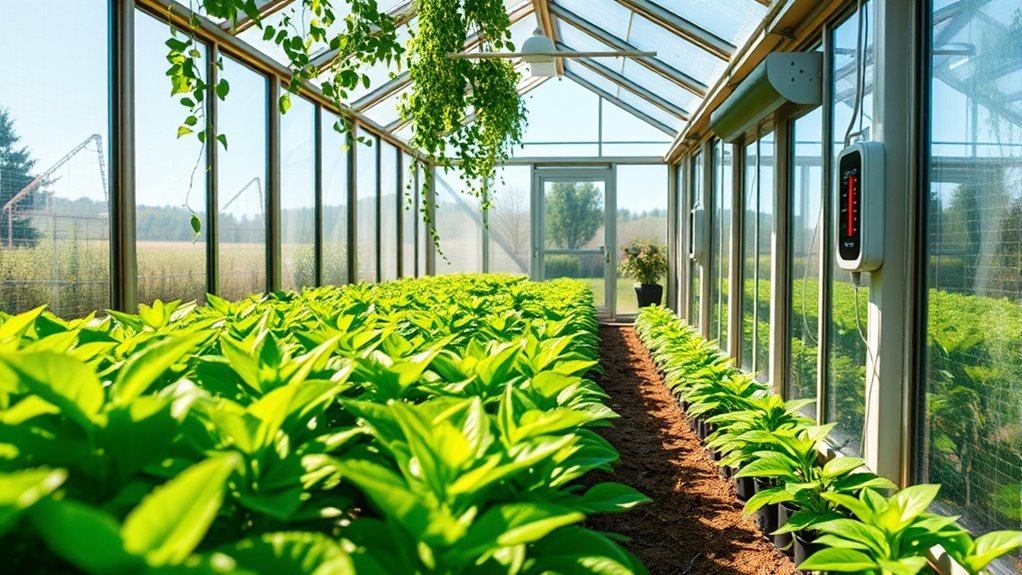
Managing climate control and ventilation in your greenhouse is essential for creating an ideal environment for your plants.
Start by using digital thermometers and hygrometers to monitor temperature and humidity levels. In cold months, consider localized heating systems like unit heaters to maintain suitable temperatures. For cooling, evaporative cooling systems can effectively reduce heat.
Automate your climate control with smart devices, allowing you to adjust settings remotely and enhance energy usage.
Ventilation is key, too. Make sure sidewall and roof vents cover 15% to 20% of your greenhouse area for effective cooling.
Automatic vent openers can help regulate airflow based on internal temperatures. By effectively managing these systems, you’ll create a thriving environment for your plants.
Maintaining Your Greenhouse and Controlling Pests
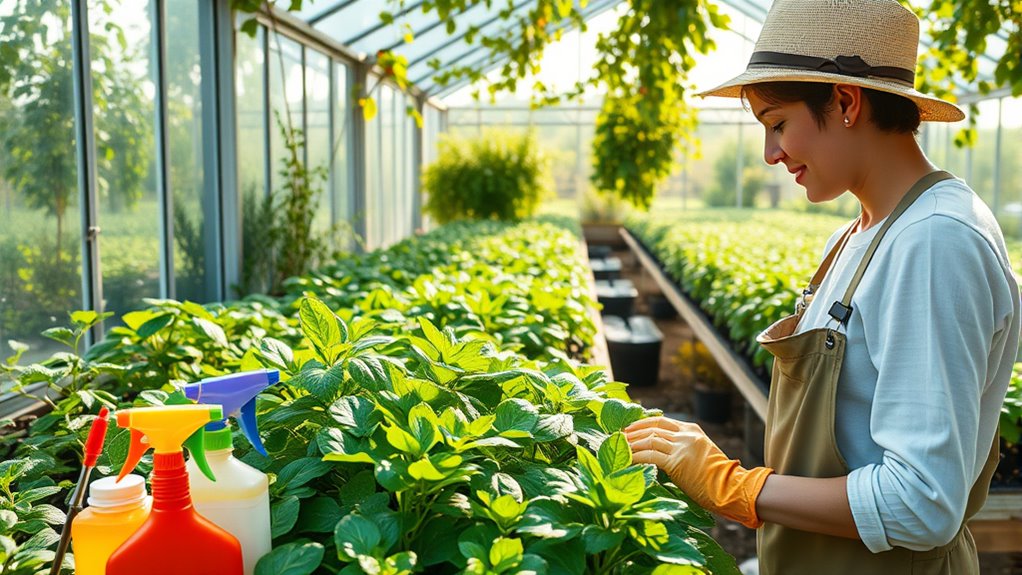
To keep your greenhouse healthy and thriving, regular maintenance and effective pest control are essential.
Start with a cleaning schedule; an annual deep clean removes algae and mold. Regularly clear out debris like dead plants and old pots, which attract pests. Sanitize tools and surfaces to prevent disease spread. Maintaining healthy soil through testing and amendments can also reduce pest issues. Additionally, incorporating essential oils can provide natural antibacterial and antifungal properties to further enhance your cleaning routine.
Monitor for common pests like aphids and spider mites using colored sticky cards. Implement mechanical controls like insect screens and strong water sprays to dislodge pests.
Consider biological methods by introducing beneficial insects, and use chemical controls like insecticidal soap when necessary. Keep records to track pest trends and refine your management strategies over time. Additionally, understanding beneficial insects can greatly enhance your pest control efforts in the greenhouse.
Frequently Asked Questions
How Much Does It Cost to Build a Greenhouse?
Building a greenhouse can cost anywhere from $2,000 to $25,000, depending on size, materials, and complexity.
For simpler structures like hoop greenhouses, you might spend $5 to $10 per square foot. If you go for a more elaborate design, costs can rise considerably.
Don’t forget to factor in site preparation, utilities, and any permits you’ll need, as these can add to your overall expenses.
It’s crucial to plan your budget carefully!
What Size Greenhouse Is Best for Beginners?
When it comes to choosing a greenhouse, think of it as picking the right-sized canvas for your gardening masterpiece.
For beginners, a compact model around 6 x 4 feet is perfect if space is tight. If you’ve got a bit more room, consider 6 x 8 or 8 x 10 feet.
This gives you flexibility to grow a variety of plants while still leaving room for expansion as your gardening dreams blossom.
Can I Use Old Windows to Build a Greenhouse?
Yes, you can absolutely use old windows to build a greenhouse! They’re cost-effective and help you create a unique design.
Just keep in mind the challenges, like ensuring proper ventilation and dealing with varying sizes. You’ll need to plan carefully to maintain structural integrity.
With some creativity and the right materials, you can turn those old windows into a charming and functional greenhouse that adds character to your garden.
How Do I Winterize My Greenhouse?
To winterize your greenhouse, start by inspecting the structure for damage and making necessary repairs.
Clean it thoroughly to enhance sunlight entry and remove clutter for better air circulation.
Choose hardy plants for winter survival, and make certain your heating system is functional.
Insulate with bubble wrap or reflective materials, and seal any gaps to prevent drafts.
Monitor temperatures regularly, and consider backup heating options for extreme cold to protect your plants.
What Tools Do I Need for Greenhouse Gardening?
“An ounce of prevention is worth a pound of cure.”
When you’re diving into greenhouse gardening, you’ll need essential tools like trowels for planting, pruners for trimming, and rakes for cleaning.
Don’t forget gloves to protect your hands!
For ideal growth, consider investing in heating systems, lighting, and ventilation.
Finally, have containers, sterile soil, and fertilizers on hand to guarantee your plants thrive.
With the right tools, you’re set for success!
Conclusion
In greenhouse gardening, remember that “patience is a virtue.” As you commence on this green journey, embrace the learning process and don’t rush the seasons. By choosing the right location, selecting easy plants, and mastering watering and climate control, you’ll create a thriving environment. Keep your greenhouse well-maintained and stay vigilant against pests. With time and care, you’ll reap the rewards of your hard work and enjoy the fruits of your labor. Happy gardening!
